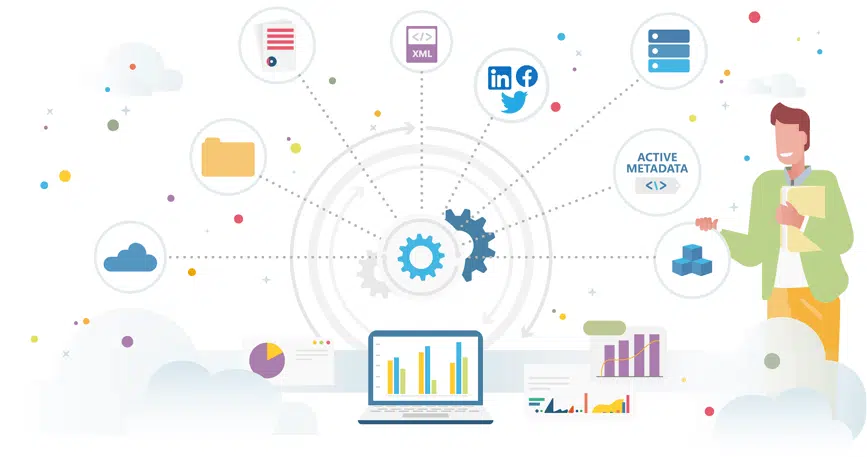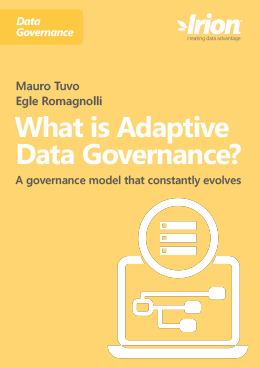
A Data Governance Hub is a model that integrates skills, roles, methods and techniques for effective, efficient and flexible data asset management and governance.
For modern businesses, data are what drives innovation. However, even today they are still mostly stored in silos and fragmented. That is, the data are not immediately available for the growing number of potential users (Business Analysts, Data Scientists, AI/ML apps, etc.). Some are organized in data warehouse, in data mart, others are stored in data lake. It is therefore necessary to make an immediate and intense integration effort. And not just that. It is essential to have a tool that makes it possible to oversee and govern data assets (Glossary, Lineage, controls dictionary, results management, etc.) and the related processes (e.g. registration of new terms, controls activation, validation, etc.).
Furthermore, let us not forget how common business events, such as fusions and reorganizations, market perturbations, changes in the regulatory environment, often lead to situations when Data Governance becomes essential. Just as it is essential for the Data Governance system itself to be able to adapt to these changes. Otherwise, the company freezes in time, unable to respond to the digital business needs. For timely and effective responses and for simultaneous implementation of different Data Management styles it is key to have highly flexible Data Governance mechanisms.
Without a Data Governance Strategy, the complexity and cost of sharing data grow exponentially. A clear strategy is vital in pursuing several objectives, such as:
- providing the data stored in silos with a unified interface,
- understanding and simplifying data streams in the company,
- profiling different actors / roles in a single point. This serves for regulating data accessibility and availability,
- effectively managing different governance styles,
- quality assurance and monitoring,
- increased extraction and sharing performance,
- evaluating data value.
What are the must-haves of a Data Governance Hub?
A Data Governance Hub can regulate different Data Management components, from organizational (roles and responsibilities) to operational (processes, procedures, workflows) to technological ones (DQ engine, Data Catalog, Data integration tools, etc).
Gartner (Adaptive Data and Analytics Governance to Achieve Digital Business Success, July 21, 2020, Saul Judah, Remi Gulzar) defines four different Data Governance styles in ascending order of business complexity and organization maturity in terms of data assets management. Each style adapts to specific models of the organization of decision-making processes:
- Control: decisions are made in compliance with centrally established rules
- Outcomes: the decision-making process aims at achieving the results by balancing risks, objectives and commitments as indicated by the company’s guidelines
- Agility: individual roles or business units are authorized to make decisions with the aim of creating value for the business
- Autonomous: decisions are made real-time based on logics, algorithms, models that are defined by human, but executed by machines.
These models can coexist within the same organization and serve specific purposes. For example, Control style can be particularly convenient for adjusting decisions in compliance with regulatory requirements. On the other hand, the Autonomous style can be applied in the context of automated real-time decisions, when AI models are applied to big volumes of data (e.g. generated by IoT technologies).
Yet the central element is the governance of data themselves. To manage data assets, one primarily needs to be able to construct an environment that can support these different styles. That is, to have effective supporting tools to enable Adaptive Data Governance. To achieve this, a Data Governance Hub must have the features related to:
- Metadata Management – as they concern managing all the information that accompanies the data, these models must be highly configurable, with the possibility to vary in time not only in content, but also in structure and access profiles. Each style can be represented by metadata that describe the corresponding framework. It should be possible for several styles to coexist in the same metadata model. There must be a solid versioning system to trace the previous model configurations.
- Connectors – to quickly access and integrate all data sources and metadata, from different sources, different environments (on premise, cloud, hybrid) and with different latency levels.
- Profiles and Permissions – to implement the organizational models in each style, also within the same model. There should be a possibility to reconstruct the history of the different configurations for these features, too.
- Workflow Management – an essential component for:
- configuring data management processes and natively integrating them with the data assets they process and the corresponding metadata;
- incorporating and orchestrating human and automated tasks;
- activating processing, control and distribution engines;
- defining roles and responsibilities within each process and varying them over time;
- monitoring processes and anticipating potential alarm and prompt automatisms;
- managing collaborations between the actors of the process.
- Augmented Data Management – automatic mechanisms to facilitate the most costly and complex tasks. These include designing controls for quality verification, implementing data preparation chains, remediation interventions.
- Performance support and reporting – to monitor the current state and the evolution of the framework through appropriate performance indicators. The functionality to implement metadata-based models that can determine data value and ROI. This helps to effectively and efficiently address data management resources.
It is often the lack of adequate tool support that creates a barrier to pursuing a data assets governance model that can use the data potential and put it at the service of the business needs.

Irion EDM: the platform for Adaptive Data Governance Hub and more.
Irion EDM is a completely metadata driven Enterprise Data Management system.
The customers use the Irion platform to build their own Data Governance Hub. They thus create an integrated and open environment to deliver numerous metadata-based data services. This is a perfect solution for data sharing and their segregation. It serves to respond to recurring questions from the management, IT and business analysts, Data Scientists, from the DPO that concern the company’s data assets, as well as to comply with the regulatory requirements.
Want to know more?
Discover through practical examples how other organizations have already started their transformation.
Want to know more?
Discover through practical examples how other organizations have already started their transformation.
You may also be interested in:

